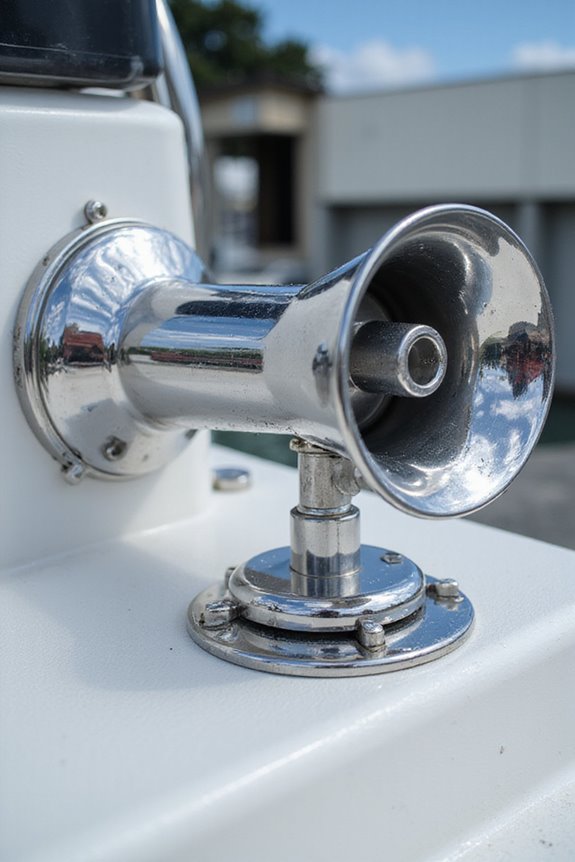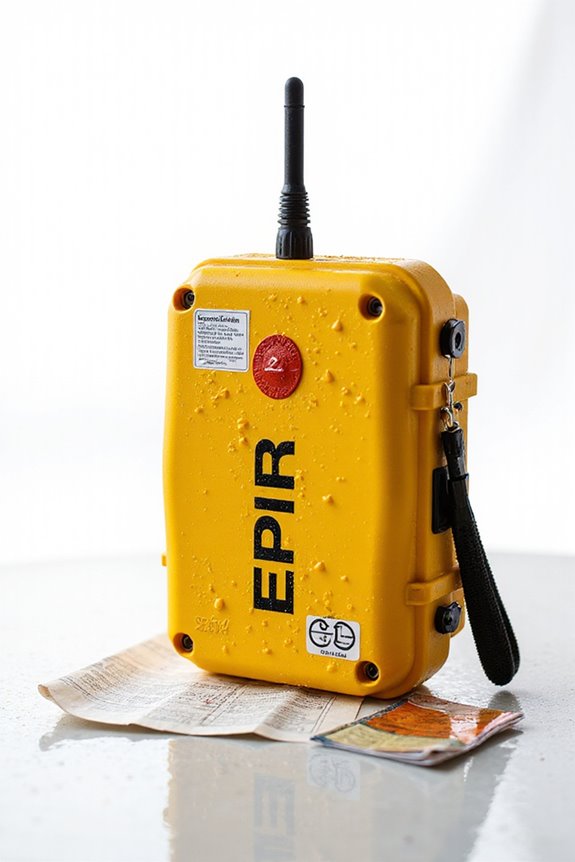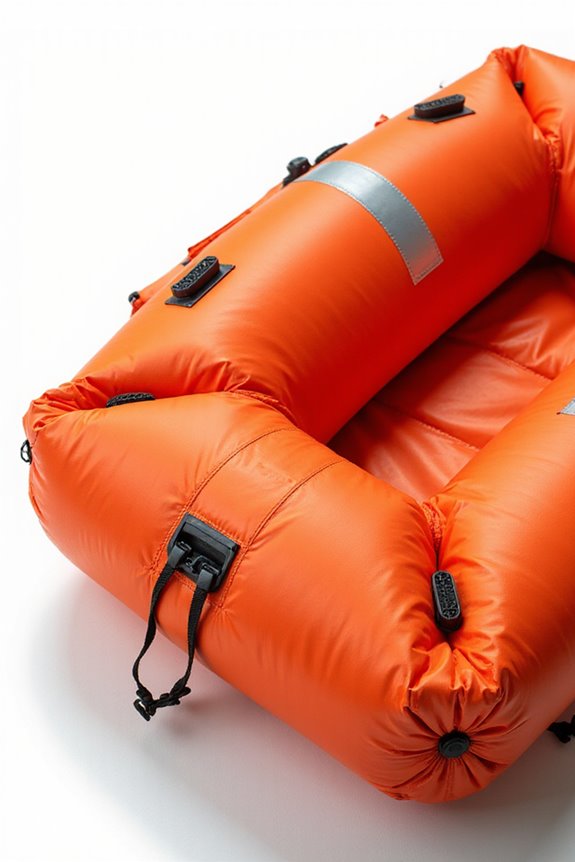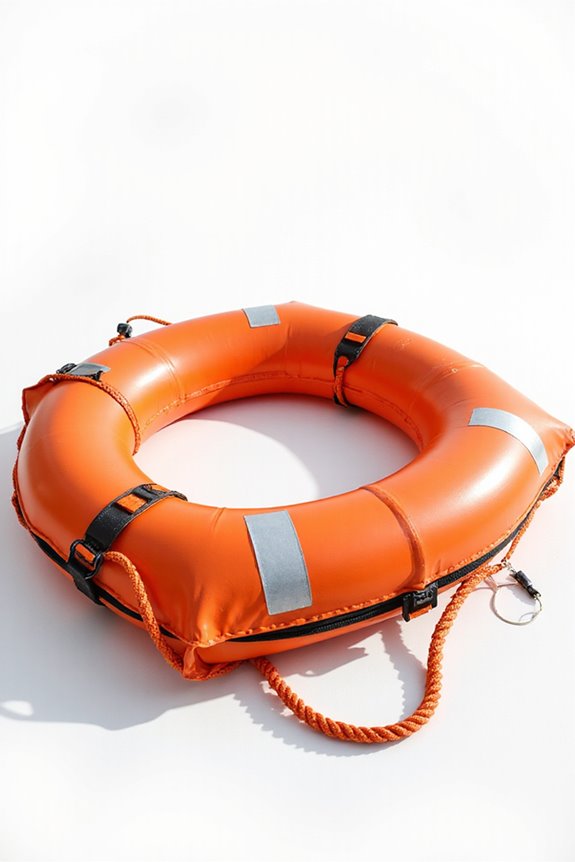When we talk marine horns, think compressed air powering a diaphragm or reed that sends out loud sound waves—you know, the kind that cut through fog or crashing waves. Their volume depends on design and air pressure, with big ships blasting up to 140 decibels (yep, louder than a jet!). Regulations, like those from the International Maritime Organization, keep usage safe and legal. Curious how tones vary or why noise matters underwater? Stick around to find out more.
Key Takeaways
- Marine horns produce sound by compressed air vibrating a diaphragm or reed, amplified by a resonator and bell for powerful signaling.
- Horn sound levels depend on design, size, and air pressure, with larger horns and stronger air yielding louder, deeper tones.
- Vessel size influences horn decibel levels: small boats reach up to 120 dB, large ships up to 134 dB, and cruise ships 140 dB.
- International Maritime Organization and COLREGS set mandatory marine horn use standards for safety and legal compliance.
- Marine horns contribute to underwater noise pollution, affecting marine life communication, requiring balanced ecological and safety considerations.
How Marine Horns Produce Sound
Let’s explore the basics of how marine horns actually produce sound—it’s not just a loud blast out of nowhere! At the heart of horn mechanics, compressed air shoots through a diaphragm or reed, causing it to vibrate rapidly. These sound vibrations create waves that travel outward, but the magic happens when the horn’s resonator and flared bell amplify those waves, making the sound carry far across the water. Think of it like us shouting into a funnel to be heard better. The length and shape of the horn then set the pitch, so longer horns hum lower tones, while shorter ones sing higher. It’s a clever blend of physics and design, turning simple vibrations into powerful signals that keep ships safe and in sync. Who knew air and metal could chat so loudly?
Factors Affecting Horn Sound Levels
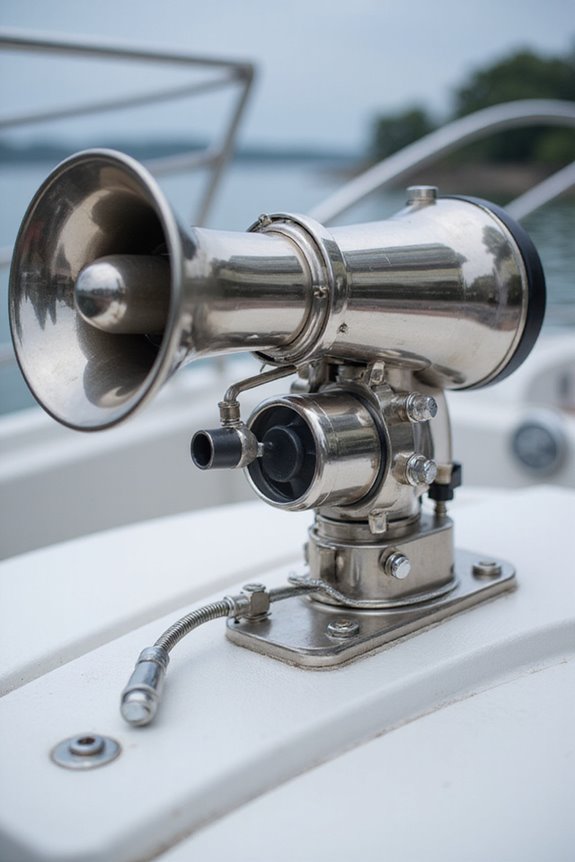
While the basics of how marine horns produce sound are fascinating, we can’t ignore the many factors that tweak just how loud and clear those horns actually get. For starters, horn design plays a huge role—things like horn size, bell shape, and the number of bells all influence volume and tone. Ever notice how bigger horns usually pack a deeper, louder punch? That’s no accident. Then there’s air supply, which is just as essential. Compressed air pressure controls not only sound intensity but also clarity; stronger air systems mean longer, more powerful blasts. So, whether it’s the physical design or the air behind it, these factors team up to shape the horn’s voice. Pretty cool how a bit of science makes that maritime “toot” heard far and wide, right?
Common Types of Marine Horns
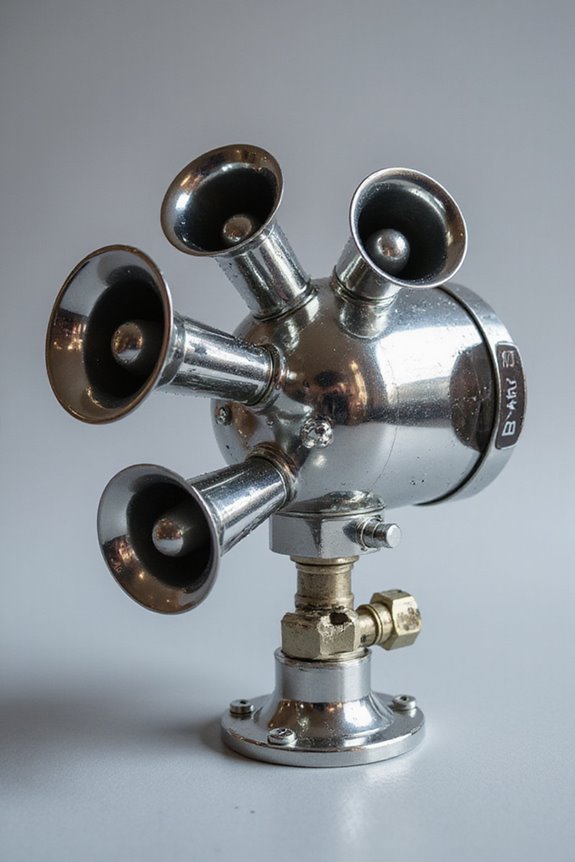
Although marine horns might seem straightforward, they actually come in a few distinct types, each with its own personality and purpose. Let’s explore the common horn types you’ll find on vessels. Air horns, the giants on larger ships, use compressed air to blast sharp, piercing signals—perfect for foggy days or long distances. Smaller boats often sport electric horns, which are quieter but easier to install and maintain—handy for your weekend adventures. Then, there are manual horns, great as simple backups when power fails or for close-range signals. Specialty marine horns, like stainless steel or sirens, fit niche usage scenarios and tough environments. Choosing the right horn type means matching your boat and needs, ensuring you’re heard loud and clear when it counts.
Understanding Horn Frequency and Tone
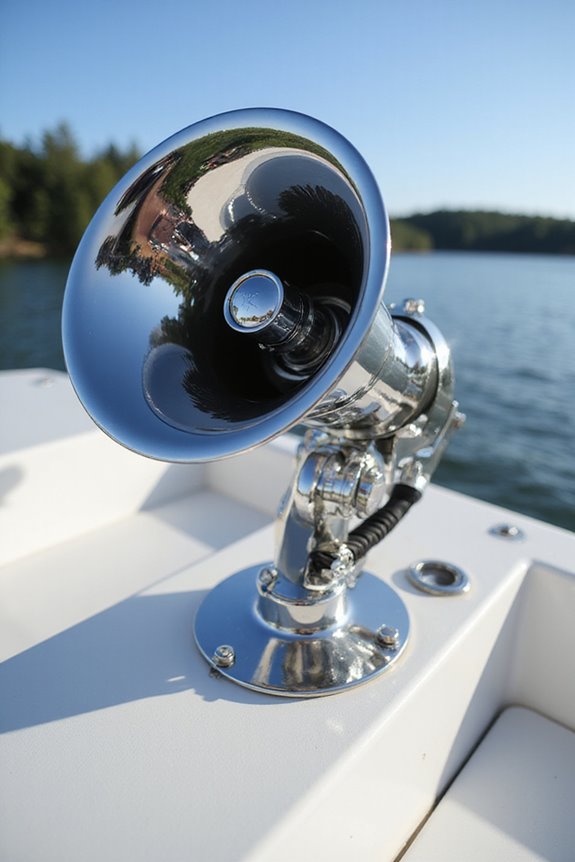
Because marine horns are all about being heard loud and clear, understanding their frequency and tone is key to making sense of how they work—and why they sound the way they do. Horn designs balance frequencies between roughly 250 and 700 Hz, hitting that sweet spot where sound propagation travels far without losing clarity. Lower tones, closer to 250 Hz, carry further—kind of like a good sea shanty reaching across the waves—while higher tones focus more on cutting through background noise. Plus, each horn’s unique tone depends on its bell shape and diaphragm material, giving it character beyond a simple beep. Ever notice some vessels use multiple horns? They space those frequencies out by at least 10 Hz, so signals stay distinct—and we don’t end up playing noise confusion bingo on the water.
Typical Decibel Ranges by Vessel Size
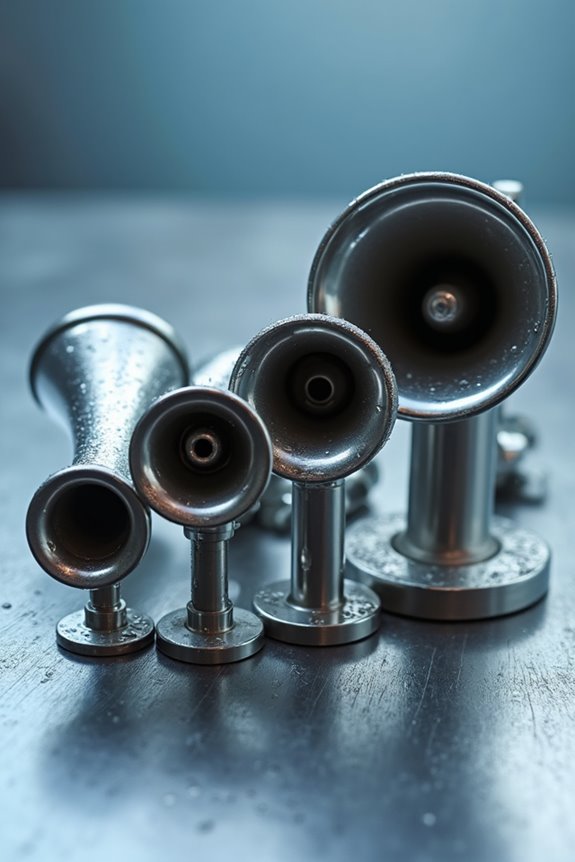
When it comes to marine horns, size definitely matters—not just for the vessel, but for how loud and far those horns need to blast. Let’s take a quick decibel comparison across vessel categories. Small boats under 12 meters usually sport horns around 100 to 120 dB—loud enough to outshout a noisy conversation but not blast your eardrums. Medium vessels crank it up between 110 and 130 dB, ensuring their signals cut through waves and engine noise effectively. Larger ships, up to 75 meters, often max out near 134 dB, making sure their presence is known a mile away. And those mighty cruise ships? They can reach a jaw-dropping 140 dB, louder than a jet engine! So, the bigger the boat, the bigger the horn—and the louder the welcome. Who knew size made such a sonic splash?
Regulatory Standards for Marine Horns
Since marine horns are not just for making noise but critical safety tools, it’s important to recognize the rules that govern their use. We all want to stay safe and avoid collision, right? The International Maritime Organization, through the COLREGS, sets clear standards on when and how to use these horns. Staying on top of regulatory compliance isn’t optional; it’s essential. Local laws add layers too, so it’s wise to know both. And remember, ignoring these rules can lead to enforcement penalties—fines or worse. Maintenance matters as much as usage; a horn that fails in a pinch is no good to anyone. So, keep your horn tested and ready, and you’re doing your part in this worldwide effort to keep waters safer for all of us.
Environmental Impact of Marine Horn Noise
Although marine horns are essential for safety, their noise adds to an often-overlooked problem: underwater noise pollution. We’re all part of a big ocean community, but marine noise from horns, shipping, and construction can disrupt marine life’s natural rhythms. Did you know animals like whales and fish rely on sound to communicate and navigate? When marine horns blast through their world, it causes stress, interrupts feeding, and even leads to habitat avoidance. These ecological consequences pile up, threatening whole populations. It’s like if we couldn’t hear each other in a crowded room—frustrating and isolating! While horns keep us safe on the water, understanding their impact helps us balance safety with protecting marine ecosystems we all share and care about.
Safe Usage and Best Practices for Marine Horns
Even though marine horns might seem like simple gadgets, using them safely and properly requires some know-how—and that’s exactly what we’ll explore together. First off, did you know horn maintenance is essential? Regular testing—ideally monthly—ensures your horn sounds crisp and reliable, avoiding those awkward silent moments when you really need it. We also need to respect signaling patterns; different blasts mean different messages, like warnings or position signals. Remember, horns are for emergencies and low visibility—not for casual use in busy harbors, where silence is golden (and legally required). Proper installation and wiring keep your horn ready for action, while handheld horns make excellent backups. By following these best practices, we help keep our waterways safe and sound—for everyone aboard and all around us.
Frequently Asked Questions
How Do Marine Horns Differ in Sound Under Various Weather Conditions?
Like a lighthouse guiding us through fog, marine horns’ sound propagation changes with weather impact. Wind, rain, and humidity affect how sound travels, but we count on these signals to keep our maritime community connected and safe.
Can Marine Horn Sound Levels Be Personalized for Private Boats?
We can’t customize marine horn sound levels freely since sound customization must align with regulatory compliance. Together, let’s choose approved equipment ensuring safety and community respect while meeting legal standards for our private boats’ horns.
What Maintenance Is Required to Keep Marine Horns Functioning Properly?
Isn’t it funny how we forget horn cleaning until it screams at us? We’ve learned to prioritize regular horn cleaning and battery check so our horns stay reliable, keeping our boating community safe and connected out on the water.
Are There Innovations in Marine Horn Technology to Reduce Noise Pollution?
We’re seeing innovations focused on sound frequency adjustments in marine horns to balance effective signaling with noise reduction. Together, we can support technologies that minimize pollution while keeping marine environments safe and connected.
How Do Marine Horns Integrate With Other Onboard Communication Systems?
It is understood horn communication thrives through signal integration, linking marine horns with VHF radios, PA, and intercom systems. This unites us onboard for clear, efficient alerts and voice communication, creating a stronger, safer community at sea.

